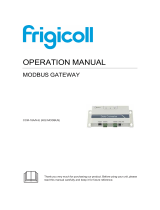
English (GB)
4
2. Introduction
2.1 About this functional profile
This functional profile describes the following modules and units:
• CIM 200 Modbus RTU
• CIM 260 3G/4G cellular
• CIM 500 Ethernet for Modbus TCP
This functional profile applies to the following Grundfos products:
• Grundfos level-control system LC 2X1 for wastewater
applications
• Grundfos level-control system LC 2X2 for water supply
applications.
Grundfos cannot be held responsible for any problems caused
directly or indirectly by using information in this functional profile.
2.2 Assumptions
This functional profile assumes that the reader is familiar with the
commissioning and programming of Modbus devices. The reader
should also have some basic knowledge of the Modbus protocol
and technical specifications.
It is also assumed that an existing Modbus network with a
Modbus master is present.
2.3 Definitions and abbreviations
0b Prefix for binary number.
0x Prefix for hexadecimal number.
3G Third-generation mobile telephony network.
4G Fourth-generation mobile telephony network.
APN Access Point Name.
ARP
Address Resolution Protocol. Translates IP
addresses into MAC addresses.
Auto-MDIX
Ensures that both crossover cable types and
non-crossover cable types can be used.
BCD Binary Coded Decimal
CAT5
Ethernet cable type with four twisted pairs of
wires.
CAT5e Enhanced CAT5 cable with better performance.
CAT6
Ethernet cable compatible with CAT5 and CAT5e
and with very high performance.
CIM Communication Interface Module.
CIU Communication Interface Unit.
CRC
Cyclic Redundancy Check. A data error
detection method.
CSD
Circuit Switched Data. Connection is established
via a fixed connection that is a physical circuit or
a reserved data channel.
DHCP
Dynamic Host Configuration Protocol. Used to
configure network devices so that they can
communicate on an IP network.
DNS
Domain Name System. Used to resolve host
names to IP addresses.
GENIbus Proprietary Grundfos fieldbus standard.
GENIpro Proprietary Grundfos fieldbus protocol.
GRE Generic Routing Encapsulation
Grundfos GO
Remote
A Grundfos application designed to control
Grundfos products via infrared or radio
communication. Available for iOS and Android
devices.
H Head (pressure).
HMI Human Machine Interface.
HTTP
Hyper Text Transfer Protocol. The protocol
commonly used to navigate the world wide web.
IANA Internet Assigned Numbers Authority.
IP Internet Protocol.
LC 231
Grundfos wastewater level-controller for one or
two pumps also supporting some basic IO
signals. It is a box for wall mounting.
LC 241/LC
242
Grundfos level-control system. Consists of a
control cabinet with the CU 24X control unit, IO
242 pump module for connection of one or two
pumps, some basic IO signals and an optional IO
241 module for extra IO signals.
LED Light-Emitting Diode.
MAC
Media Access Control. Unique network address
for a piece of hardware.
Modbus
A serial communications protocol commonly
used in industry and building automation
systems.
Modbus RTU
Modbus is a fieldbus used worldwide. The CIM
200 RTU version is used for wired networks
Modbus TCP
Modbus is a fieldbus used worldwide. The TCP
version is adapted for use as an application
protocol on TCP/IP using either CIM 260 3G/4G
cellular or CIM 500 Ethernet as basis.
PIN Personal Identification Number. For SIM cards.
Ping
Packet InterNet Groper. A software utility that
tests the connectivity between two TCP/IP hosts.
PUK Personal Unblocking Key. For SIM cards.
RTU Remote Terminal Unit.
SELV Separated or Safety Extra-Low Voltage.
SELV-E
Separated or Safety Extra-Low Voltage with
earth connection.
SIM Subscriber Identity Module. SIM card.
SMA
SubMiniature version A. Coaxial radio signal
cable connection standard.
TCP
Transmission Control Protocol. Protocol for
internet communication and Industrial Ethernet
communication.
TCP/IP
Transmission Control Protocol/Internet Protocol.
Protocol for internet communication.
Transmission
speed
Bits transferred per second, bits/s.
URL
Uniform Resource Locator. The IP address used
to connect to a server.
UTC
Coordinated Universal Time. The primary time
standard by which the world regulates clocks and
time.
VPN
Virtual Private Network.
A network using the internet to connect nodes.
These systems use encryption and other security
mechanisms to ensure that only authorised users
can access the network and that the data cannot
be intercepted.























